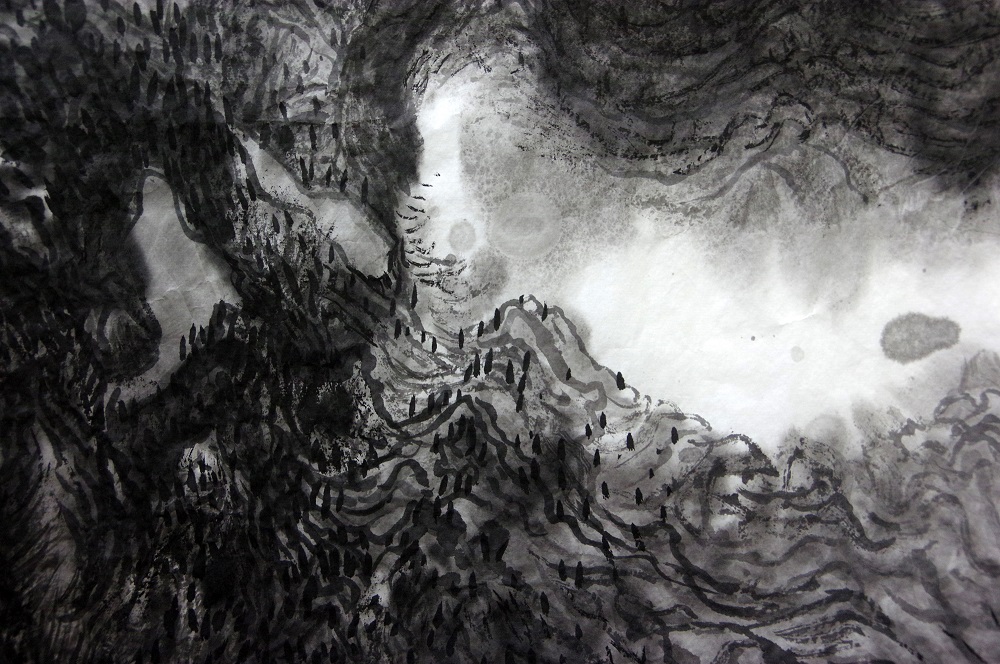Summary |
A study of the ancient Chinese methods of ink and wash landscape painting |
|---|---|
Start Date |
Feb 26, 2018 12:00 pm |
End Date |
Mar 7, 2018 12:00 pm |
Venue |
Plimsoll Gallery |
Wrinkles in Time - Folding Song Dynasty into Contemporary Art
Image credit: Dreams of Song Dynasty, 2017, Chinese rice paper, ink and wash, 68 x 140 cm. Courtesy of the artist
Opening event: Friday 2 March 2018, 5.30 – 7.00 pm
Exhibition dates: Monday 26 February – Wednesday 7 March, 2018
Gallery Hours: Wed - Mon 12pm - 5pm (during exhibitions)
Closed Tuesdays and Public holidays
Abstract
This research project builds on insights from a study of the ancient Chinese methods of ink and wash landscape painting in particular through a focus of Song Dynasty landscape painting. My research seeks to produce artworks that explore the potential in, and re-contextualise, the ancient tradition of the Wrinkle method (texture method) within Song Dynasty ink and wash work in order to innovate the tradition.
The following questions inform the research:
What can Song Dynasty ink and brush (wash) paintings offer contemporary art practice?
How does ink and wash landscape paintings reveal Chinese philosophical thought, especially the philosophy of Yin and Yang, within environments outside of that tradition?
How can the practice of calligraphy be re-contextualised within a contemporary art practice to communicate Yin and Yang philosophy in relationship to the landscape?
How might the process of using ink and wash wrinkle methodology develop a new visual language that enters into a dialogue with contemporary art practice?
My research starts from a rethinking of the relationship between calligraphy and the traditional landscape painting techniques of the Song Dynasty, in order to understand the aesthetic properties of Chinese brush and ink work (Bi Mo - 笔墨-Wrinkle methods). In order to define my research project, I explore the relationship between Song Dynasty paintings and Taoist philosophy (three key features of Yin-yang and three key elements of Qi). I draw out four key qualities from the relationship: unity or harmony, transformation derived from continual change, complementary opposites, and spatial duration.
In order to innovate these relationships I draw from the theme of the four seasons, as it pertains to the environments around Hobart. I focus on the mountain and rock forms that populate the view of the Mount Wellington range. This cross-cultural approach maintains a distinctively Chinese character through its philosophical inputs but moves beyond the boundaries and visual modes of traditional Chinese landscape painting to draw connections between two different environments with the aim of developing a new visual language for facilitating cross-cultural communication.
In order to provide more insight into how the individual character of Song Dynasty landscape art has located the visual language used in this project, and to construct a cultural common ground for the studio inquiry, I have drawn from ancient Chinese painting texts: ‘An Appraisal of Painting’ (Xu Hua), ‘An Introduction to Landscape Painting’ (Hua Shanshui Xu) ‘Landscape Lecture’ (linquan Qao Zhi), and ‘universal theory of pure landscape painting’ (Shanshui Chun Quanji) as a theoretical framework.
In this study, I visited contemporary artists working with traditional painting in China, and I have analysed representative works of ink and wash from the Song period to the present day, in order to trace the relationship between them. Notable examples include Ting Qiu, Huayi Li, Brice Marden and Dongling Wang. The purpose is to tease out the cultural uniqueness from which an international visual language can occur.
Through this research, Song Dynasty landscape painting has informed my approach in thinking about the landscape and expressing the way of natural law, which maintains the balance and harmony of Yin and Yang in painting through mutual transformation of Qi and energy, in order to express the strong movement within nature through a smoothly flowing line. This movement reveals the energy that transforms Qi in my work. The different movements that I make in this environment are exactly suited to reflecting the rhythm of life in Tasmania – this is also predicted by Qi’s theory of energy transformation, so that a change in location is also a change in the relationship between water and ink – all of which emerges naturally and which also has a different quality to the works of the Song Dynasty.
